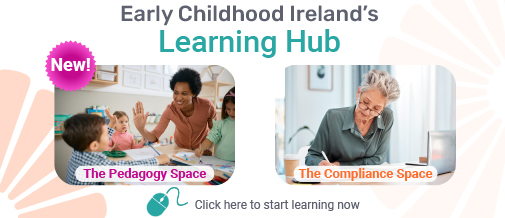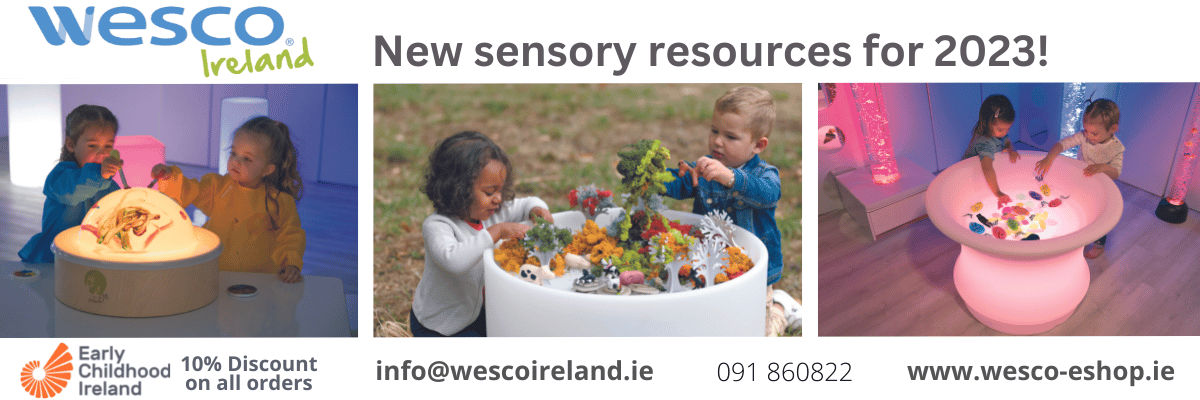Promoting Inquiry Based Learning (IBL) with Stones

In this week’s Scéalta blog post Dr Evelyn Egan looks at the potential of stones to support children to explore creativity and Inquiry Based Learning, with lovely ideas for summer explorations, that can also be used later in the year too.
Theoretical Background
Learning-by-doing, also termed inquiry-based learning (IBL) is a theory of education expounded by the renowned educational reformer and philosopher John Dewey (1934). When applied to the process of art-making, it allows young children to question, explore and investigate ideas, while equipping them with essential life-skills to navigate their world. Their involvement empowers them to move beyond an understanding of what is and probe deeper into the realm of possibility.
The associated term, Transdisciplinarity (TDA), first coined by Piaget in 1970, is defined as ‘a total system without any firm boundaries between disciplines’ (Piaget, 1972:138). Learning is approached holistically, and topics of study are not divided into discrete categories. The French philosopher Morin (2001), who embraced Piaget’s theories, warned of the necessity for educators to move away from the didactic model, to reconceptualise our understanding of modern education and place the child at the very centre of learning. In so doing, children will learn in a way which will best equip them to face the demanding and different challenges of tomorrow. When TDA is applied to the visual arts, the spirit of art permeates every subject.
Practical engagement in the creative process
Practical engagement in the visual arts has notable benefits for young children. It assists in developing skills like communication, problem-solving, critical and creative thinking. It enhances social and emotional wellbeing and affords the opportunity for self-expression and meaning-making. Children can explore and communicate ideas, thoughts and feelings, through open-ended creative processes which facilitate a vast range of interpretations and expression.
Before embarking on designing a curriculum for young learners, the practitioner needs to question the purpose of the creative process. To ensure that each child’s well-being is nurtured and their creativity tapped, the following is a list of helpful questions we can ask ourselves.
How will this learning opportunity;
- foster curiosity?
- promote creativity?
- inspire imagination?
- enable each child to visually express individuality?
From Theory to Practice
This blog-post describes how the free and found example of stone can generate myriad possibilities, when translating theory to practice and following children’s interests.
Stone as a provocation
The stone is used as a ‘provocation’, a starting point, to introduce the seven elements of art; line, shape, form, space, texture, colour and value. It’s an invitation for children to participate in the cycle of inquiry through the process of exploration, investigation and discovery.
When choosing stones, consider their qualities, e.g. shape, size, tone, texture. Select a variety of large, flat stones to act as drawing surfaces and smaller ones as mark-making tools (development of palmer and pincer grasp). Stones of varying length and breadth and depth assist in exploring line, shape, form and texture. Stones of differing sizes, weight and scale allow for the introduction of mathematical concepts.
Preparing the learning opportunity
Take children outdoors and if practicable on a nature walk to collect stones. This provides a context and involves children from the beginning.
Invite each child to describe their stone. How does it feel? Is it hot or cold? Rough or smooth? Big or small? Drawing attention to the artistic elements. Children then add their stones to a collection.
Preparing the provocation table

Give consideration to the aesthetics of the provocation i.e. neutral background, void of visual distractions. Use a tonal range which is harmonious with the selection of stones. Large flat stones as drawing surfaces and smaller drawing-tools in the centre for easy access.
Mark-making on stone

Invite each child to draw on a big stone, using a smaller one as a drawing tool.Mark-making is crucial in child development and learning, including fine motor development, i.e. pincer grasp.
Painting on stone




Paint with water on stone. Invite children to describe what happens to the different stone surfaces when they ‘paint’ lines and patterns e.g. absorption, pooling, transformation from dull to shiny, rough to smooth.
Stone and Mathematical Concepts

Use stone as an opportunity to build an understanding of mathematical concepts. Develop numeracy by writing numbers on stone. This draws attention to the relationship between symbols, and quantity. Increasing size of stone to correspond with increasing numbers, further develops an understanding of small to big. Exploration of weight and numbers-include weighing scales.
Stacking stones


Invite children to stack stones on scales and note the relationship between quantity and numbering. Children develop hand-eye coordination, fine motor skills and balance, life skills (perseverance, patience, turn-taking).
Circles in stone

Invite children to stack stones on scales and note the relationship between quantity and numbering. Children develop hand-eye coordination, fine motor skills and balance, life skills (perseverance, patience, turn-taking).
Categorizing stones
Invite children to engage in ephemeral art and be inspired by stimuli such as the visual art processes undertaken by famous land artists, e.g. Andy Goldsworthy or James Brunt.

Encourage children to observe similarities and differences, by grouping, i.e., tonal range, surface texture, artistic elements and geology.
Shape and form in stone

Find recognisable shapes amongst stones as they explore shape, size and scale developing mathematical language- smallest to biggest. Introduce children to 3D shapes.
Extend learning
- History and heritage; Show children a picture of Beehive Huts in West Kerry, marks in Ogham stones or Connemara walls.
- Physics: Invite each child to drop a stone into a pan of water. What happens if/when? And- Why? questions; Displacement of water, Buoyancy.
On-going learning
Language acquisition: Children can describe the drawing/painting and construction process and stone qualities.
Turn taking, sharing, problem-solving, collaborative learning.
Health and Safety; the Why and What if? and ‘Danger’ questions to stimulate discussion.
This blog post illustrates some of the multiple avenues of inquiry using a transdisciplinary approach to visual arts experiences.
References:
Dewey, J. (1934) Art as Experience, New York, Kappa Delta
Morin, E. (2001) Seven Complex Lessons in Education for the Future. Paris: UNESCO Publishing.
Piaget, J. (1972) The Epistemology of Interdisciplinary: Problems of Teaching and Research in Universities, Paris: Organisation for Economic Co-operation.
Bio-data

Evelyn Egan is a lecturer in the Visuals Arts EYE BA programme at Munster Technological University (MTU) since 2006. She previously worked at Scuola di Grafica Venice and later as Head of Art at the International School of Padua, Italy. She recently completed her PhD in Early Years Education, entitled: Inquiry-Based Emergent Curriculum using a Transdisciplinary Approach to the Visual Arts in Early Childhood Education and Care: Implications for Policy, Education and Practice. She has also contributed to the Aistear Síolta Practice Guide and Better Start Resources for Practitioners which can be viewed here. A more in-depth view of her work on the Initial Professional Education programme at CIT is published in the World OMEP Journal Theory into Practice 2019 and can be viewed here.









